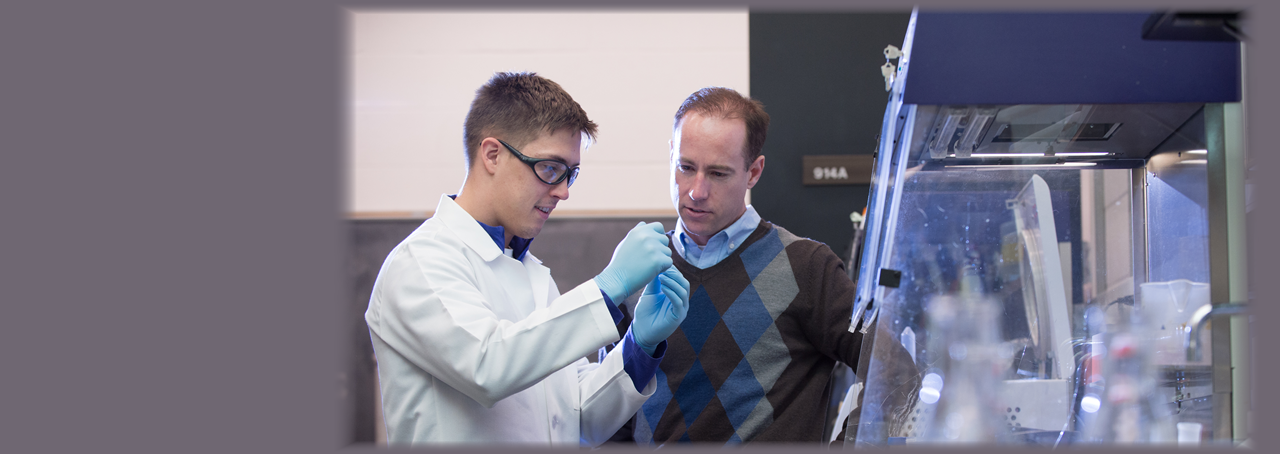Vaccine provides double-whammy protection against Staph infections
Staphylococcus aureus bacteria occur naturally on the skin of some 25-30 percent of healthy people. When the skin is broken, these bacteria can cause infections, such as abscesses (boils) and cellulitis, and can even turn deadly when they enter the bloodstream.
Often, S. aureus infections are treatable with antibiotics, but some methicillin-resistant S. aureus (MRSA) strains can cause significant problems. In fact, according to the Centers for Disease Control and Prevention (CDC), 11,285 people died from complications related to MRSA in 2011.
A new vaccine under development at the University at Buffalo could prevent S. aureus infections and even, in the case of MRSA, save numerous lives. Blaine Pfeifer, professor of chemical and biological engineering, is leading the charge.
“The go-to when someone gets a bacterial infection is antibiotics, but if those aren’t effective that can be a big problem,” says Pfeifer. “If you can develop a vaccine for Staph, you can train the body to fight the infection on its own without the need for antibiotics.”
According to Charles Jones, a UB alumnus who earned a PhD in Pfeifer’s lab and the current CEO at Abcombi Biosciences, Inc., previous efforts to produce a vaccine for S. aureus have failed, with the exception of a Pfizer drug that targets a narrow patient population of adults undergoing elective spinal fusion surgery.
“Our objective is to develop the world’s first universal Staph vaccine by designing a product that is capable of preventing two key stages of pathogenesis: colonization and dispersion of virulent bacteria to sterilize sites.”
With assistance from the SUNY Technology Accelerator Fund (TAF), Pfeifer and Jones are creating such a vaccine, and they hope it will one day be available to everyone. Pfeifer notes, “The idea is that children would get vaccinated and that they would be protected from Staph infections throughout their entire lives.”
According to Pfeifer, TAF aims to foster activity at the intersection of research and commercialization. “We think our vaccine is commercially viable, and the Research Foundation agrees with us,” he says. “We are using our funding to start the ball rolling and get the preliminary data we need to build the vaccine.” Abcombi’s role in the project is to provide Pfeifer with a commercial partner to accelerate pre-clinical development and operationalize the vaccine.
The team is basing the development of its Staph vaccine on a previous vaccine it created to prevent pneumococcal disease, which causes often-deadly pneumonia.
Like Streptococcus pneumonia, S. aureus has a trick up its sleeve. “After you’ve been colonized by S. aureus, there is often a secondary event, or later stage of progression, where the bacteria become virulent,” says Pfeifer. “Traditional vaccines only prevent bacteria from entering the body. Our vaccine will both prevent the bacteria from colonizing the body and prevent any bacteria that do enter the body from developing into deeper forms of infection.”
To create the pneumococcal vaccine, the team designed a liposome (or a tiny liquid-filled bubble made of fat) that carries antigens—small pieces of an organism, in this case, pieces of S. pneumoniae. The antigens were acquired from numerous strains of S. pneumoniae at different stages of the bacteria’s development. Being exposed to these antigens compels the body to launch an immune response, thus building up its immunity to different strains of the bacteria and to different stages of the bacteria’s development.
This strategy, says Pfeifer, offers a deeper level of protection because the bacteria can shift its function and structure at different stages of the disease progression. “We are trying to account for those variations,” he says.
Pfeifer explains that the team’s Staph vaccine will work the same way by taking into account the different strains and infection stages of S. aureus. “We are using the same scientific philosophy and technical capabilities to build a new vaccine,” he says.
According to Pfeifer, the vaccine has the added benefits of being relatively easy and cheap to assemble, and is safe for use in the body. “The chemistry works in such a way that we can basically add the ingredients together and they self-assemble into a vaccine,” he says. Also, he adds, “the components are all very mild things, like lipids—things that are not dangerous at all.”
Ultimately, the team hopes to advance its vaccine through FDA approval. “There is still a long way for us to go to get to that point, but our early data look really good,” says Pfeifer.
comments powered by Disqus


